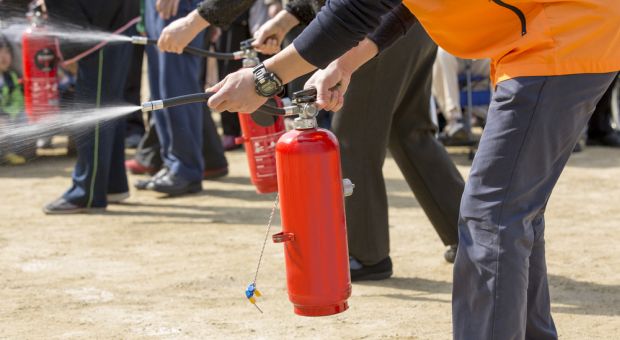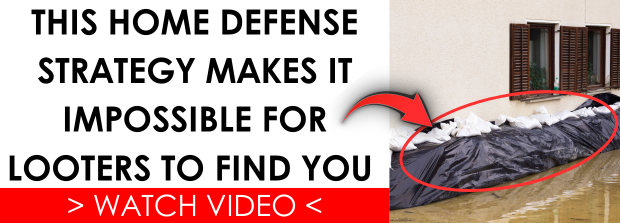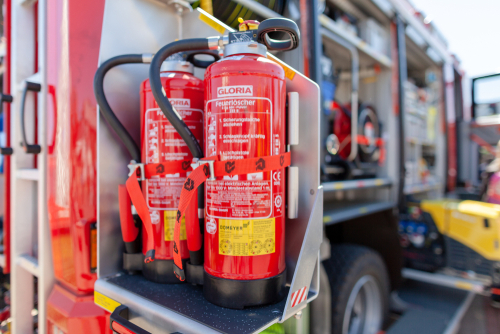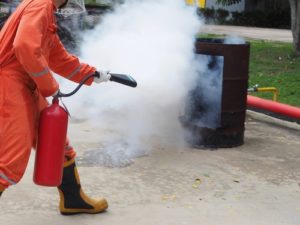Defending yourself and your family from any number of situations can be complicated by many things.
Surprisingly enough, something as simple as a fire extinguisher can be used to stop anyone from a home invader intent or rape or murder to an active shooter in a school or other setting where large numbers of lives are at stake. Knowing how to use fire extinguishers for the purpose of self defense can easily save your life.
The big red Class A, B, C fire extinguishers or other types of fire extinguishers are usually found in stores, hospitals, schools, restaurants, and other settings where you may not be able to carry another kind of weapon.
An Introduction to Fire Extinguishers
Regardless of the type or size of a fire, it must have the following four elements:
- Fuel
- Sufficient heat to keep the temperature of the fuel at or above the kindling point.
- Oxygen
- Sufficient resources to generate a chain reaction.
While fire extinguishers may vary in terms of the chemicals used in them, they all act to remove one or more of the four main items. Since fires can also vary in terms of how these four elements are combined, you will find that the classes of fire extinguishers are also specialized to put out each class of fire as quickly and safely as possible.
Classes Of Fire
Not all fire extinguishers are optimal for use as self defense tools. As such, when you are in a public area, it helps to know what kinds of fire may break out in the building. This can help you gage which kinds of fire extinguishers are likely to be available, where to find them, and what how best to use them as a non-lethal self defense tool.
- Class A – These are most common fires and rely on fuels such as wood, paper, fabric, plastics, or trash. These fires are commonly put out with water or monoammonium phosphate.
- Class B – For fires that use flammable liquids and gases as fuel. Some common liquid based fuel sources include gasoline, kerosene, oils, or oil based paints. Insofar as gas vapor fires, Common fuels include butane or propane. To fight these fires, the chemical in the fire extinguisher acts to “smother” the fire by preventing oxygen from getting to it.
- Class C – Electrical fires. This class of fire uses electrical components and/or energized equipment as a fuel source. Electric fires can be caused by overloading wiring or circuits. Never use water or a fire extinguisher not classified for Class C fires to put out an electrical fire because the current will follow the water trail directly to you.
- Class D – Use combustible metals such as titanium, magnesium, aluminum, and potassium as a fuel source. Fire extinguishers for this type of fire rely on a powdered agent that absorbs heat. The powder also smothers the fire and prevents oxygen from reaching it.
- Class K – These are usually used for cooking fires and are designed to put out fires that use a range of materials as fuel. Fires using grease and cooking oils to vegetable fats or animal fats can be extinguished using a Class K extinguisher. As with electrical fires, you should not use a fire extinguisher other than a Class K for this fire type. If you use the wrong type of extinguisher, you run the risk of spreading the fire.
Types of Fire Extinguishers
Here are the basic types of fire extinguishers you are likely to encounter and some defense considerations.
As you can see, their classification matches the fire types they are meant to be used on.
ABC Powder Extinguishers
These portable, hand held multi-purpose fire extinguishers are the most popular in use today. When aimed and deployed against a fire, they spray a very fine chemical powder called monoammonium phosphate. This powder blankets the fire and suffocates it. ABC powder extinguishers work on all Class A, B, and C fires. Monoammonium phosphate will also break the chain reaction that is often associated with Class B fires. Since this powder is not an electrical conductor, it is also safe to use on all Class C electrical fires.
The average ABC fire extinguisher weighs about 5 pounds and is made of aluminum. The weight makes it a good bludgeoning weapon that can incapacitate an individual. To achieve this, however, you will need the element of surprise on your side. Chances are, you will not succeed if the perpetrator is armed with a gun or knife. Using an extinguisher as a bludgeoning weapon requires the user to use both hands to get a good grip on it. Since both your hands will be full, it won’t leave you a way to divert the attacker’s weapon or disarm them.
Insofar as self defense, you will find ABC powder extinguishers are some of the best to use in both home and public places. Usually, there are several of them in any given public building and located in prominent locations. They are easy to operate and very effective once deployed. The average 5 pound dry chemical fire extinguishers can shoot a stream of powder 15 to 20 feet and will cover an area much larger than the area covered by pepper spray. The high pressure emitted by these fire extinguishers can be enough to slow, stop, or otherwise incapacitate active shooters, or other criminals.
The dry powder chemical stream creates a large thick choking cloud that can defuse the situation quickly. Getting a lot of the dry chemical powder in your eyes can cause tearing and burning. If the powder gets into your nose and mouth, it can cause nose and mouth irritation, and possible breathing problems. The diversion caused by spraying down the attackers could give someone else time to disarm the attackers and/or depart the danger area.
The best way to use the fire extinguisher for self defense is to keep the hose attached to the body of the extinguisher. This will keep the target person from grabbing the hose and try to pull it away from you. Hold the grip of the extinguisher with your strong hand and support the body of the extinguisher with your non-dominant hand. With the thumb over the hose to keep it in place, point the hose opening at the shooter’s face. Keep spraying until the extinguisher is empty. When the canister is empty, thrust the empty canister into the shooters face, chest, or gut repeatedly. If you are lucky, this will provide the shooter enough distraction/injury so that someone else can disarm them and finish neutralizing the threat the perpetrator poses.
Consider a situation where an active shooter has their back to you. Spraying quickly from behind may be enough to stop them and cause them to turn in your direction. Once they turn, you will have to fire the extinguisher again at their face and hope they don’t fire the gun at you.
Of course, if you were carrying a gun instead of being prohibited from doing so by “no gun allowed” signs, then you would not have to take the risk of being slaughtered while trying to defend yourself and others. As an aside, if you are in a public place with “no gun allowed” signs and you have to use a fire extinguisher for self defense, you can and should expose the business for failure to protect you while on their property via social and mainstream media venues.
It is also absolutely necessary to sue the business specifically related to not having sufficient security guards to secure the premises and also preventing you from defending yourself. You should also file with the BBB and other consumer protection groups, especially if you have already been injured in these establishments, mugged, raped or stalked in their parking lots, or otherwise become the victim of a crime while on their property.
Even though random shooters tend to be unprepared for people to fight back, terrorists are ready for anything.
You can expect to have to fire in their face in order to temporarily blind them. In order to succeed, it may take two or more people to stop the attack. The first person with the fire extinguisher would spray the perpetrator until the canister is empty, and then beat them with the empty cylinder. Other people will need to take action to disarm the person or do whatever else it takes to stop them. Unfortunately, the vast majority of gun control advocates never seem to recognize, let alone admit the fact that the only thing that can stop a criminal with a gun is a non-criminal with a gun. No sign, law, restraining order, or “people/society should not…” will change that.
Wet Chemical Fire Extinguishers
Class K extinguishers are a specialized type of wet chemical extinguisher that uses potassium based solution. While it is mainly designed for kitchen related cooking fires, it can also be used on Class A wood or trash firers. This extinguisher works in two ways. First, it cools the fire with a mist. Second it combines with fats or grease to form a thick soapy substance that seals the surface of the liquid. This prevents flash back re-ignition.
While they can irritate skin and eyes, they don’t have sufficient force to knock a perpetrator over. Since they weight around 5 pounds, they can also be used as a bludgeoning tool. Overall, I don’t recommend them as a primary fire extinguisher for self defense.
Carbon Dioxide (CO2) Extinguishers
This fire extinguisher uses pressurized CO2 to put out Class B fires (of flammable liquids) and can also be used to safely put out electric fires. CO2 acts to remove oxygen from the fire, thus suffocating it. CO2 extinguishers are very clean to use because they don’t leave any additional residue to clean up.
These extinguishers usually weight 10+ pounds, which can pose a problem for some people. They are also not as safe to use. If deployed incorrectly, you can get frost bite if the CO2 lands on your skin. When aimed at the perpetrator, the CO2 will cause immediate freezing of unprotected skin or eyes and carbon monoxide poisoning.
If you are going to have a CO2 extinguisher at home, bear in mind they can be very expensive to refill. They must also be properly maintained. This includes yearly cylinder service and testing, plus a 10 year pressure test. Aside from making sure the extinguisher will work in an actual emergency, annual maintenance reduces the risk of the handle being blown from the cylinder or cylinder cracking and releasing its contents into your home.
Overall, if I had to choose between an ABC and a CO2, I would go with the ABC for self defense. If no ABC is available, a CO2 would be my second choice.
Foam Extinguishers
These extinguishers work by using a type of foam that expands when it comes into contact with air and forms a blanket over the fire. This foam blanket prevents the water vapor generated by the burning process from rising. When this is done properly, the fire dies from lack of fuel and oxygen. The trapped water also creates a cooling effect that helps to kill the fire faster. Foam extinguishers work well on Class B flammable liquids such as gasoline, but don’t work on gaseous fires. The Foam extinguisher can be used on Class A fires that involve solid combustibles like wood.
These extinguishers work fine for fires, but have mixed results when used as a self defense weapon. They don’t have the force or shock power to knock down an attacker or otherwise deter them. Even though the foam may irritate skin and eyes, it isn’t likely to be a sufficient deterrent. On the other hand, the canister weighs about 5 pounds and can be used as a bludgeoning tool.
Clean Agent Extinguishers
This type of fire extinguisher uses a gas that reduces the oxygen levels and impedes the chain reaction. The gas is stored in it’s liquid form. When the extinguishers are activated, the liquid form is released into the air where it converts back into the gas state. Clean agent extinguishers do not conduct electricity, leave no residue, and dissipate quickly. Typically, these extinguishers use Halon gas and may be found in rooms filled with electrical equipment and computers. This extinguishing system can also be used for Class B and C fires.
Of all the fire extinguishers, these are the worst for self defense. They don’t irritate eyes or skin, nor do they cause breathing problems. Although they do remove oxygen, it isn’t enough to incapacitate a perpetrator. A portable extinguisher canister will weight about 5 pounds. You can use it as a bludgeoning tool if you had to.
Water Mist Extinguishers
This extinguisher releases microscopic water molecules that fight a fire on many levels. First, the extinguishers releases water in a fog-like form which decreases the level of oxygen in the air and helps to suffocate the fire. Second, the water particles are pulled into the fire, which lowers its temperature. Since the water in the Mist extinguishers has been de-ionized, it will not conduct electricity. Therefore, this type of fire extinguisher can be used on electrical fires. They can also be used on burning liquids and gases that standard water extinguishers could not be used on. To put it simply, this extinguisher can be used safely and effectively on Class A, B, C, and K fires.
These fire extinguishers are great on fires, but are almost useless as a self-defense weapon. The mist isn’t emitted forcefully enough to deter a human attacker. It might act as a minor distraction, but I would not risk my life on it…
How To Use Fire Extinguishers for Self Defense
Before using any type of fire extinguishers as a self defense weapon, you must learn how to use them safely and correctly. To do this I would recommend taking a good fire safety training course and get some experience actually using them on fires so that you can take that information and adjust it for self defense purposes.
To use fire extinguishers remember the word PASS:
- Pull the pin. With the fire extinguisher nozzle pointing away from you, release the locking mechanism.
- Aim low. Point the extinguisher at the base of the fire.
- Squeeze the lever slowly and evenly.
- Sweep the nozzle from side-to-side.
What to Do After Being Sprayed By A Fire Extinguisher
The following are general First Aid measures to use if a person is sprayed by a fire extinguisher:
Skin Exposure
- Remove clothing that has residue from the extinguisher on it. Take care not to get powders or other materials in the person’s eyes.
- Flush the affected area with running water.
- If skin irritation occurs, take those affected to the nearest emergency room.
Eye Exposure
- If the fire extinguisher was being used as weapon and the perpetrator’s face was very close to nozzle, it is possible they will be temporarily or permanently blinded.
- If any wet or dry chemicals are splashed into the eyes, open the eyes under running water and flush for at least 15 to 20 minutes. If this doesn’t work take them to an ER for further treatment.
Inhalation
- If any of the fire extinguishers active agents are inhaled, get victims immediately into fresh air. This goes for anyone that was in the room when the extinguisher was deployed and may have inhaled some of the chemicals.
- If the victim’s heart or lungs are not working, use CPR to re-establish cardiopulmonary function.
- If lung, throat, or nose irritation occurs, take those affected to the nearest emergency room.
Ingestion
- If any of the fire extinguisher contents are swallowed, call a poison control center at once or an ER for the most current information.
- Don’t induce vomiting if professional advice is not available.
- Victim should drink milk, egg whites, or lots of water.
- Never give milk, water, or induce vomiting to anyone who is unconscious, who can’t swallow, or is having convulsions.
- If this exposure causes obvious medical problems to the victim or rescuers, take them immediately to an emergency room. Be sure to bring along the extinguisher label and a copy of the Material Safety Data Sheet (MSDS) that should be in the place where you found the extinguisher.
In a time of great need for self defense, fire extinguishers can be used with varying degrees of success. A great deal will depend on the kind of fire extinguisher that you have on hand as well as the kind of weapons that the attacker has. Since all public buildings and garages have fire extinguishers in plain sight, you can and should learn how to use them as a last ditch defense. You can also use them for home defense if nothing else is available.














































































Great, and useful article as always. BTW…defuse, not diffuse.
Thanks a lot, Michael 🙂 Also, we changed the wrong word.
Hi, Fred. Good article. When using a CO2 extinguisher you probably meant to say CO2 (carbon dioxide) poisoning not CO (carbon monoxide) poisoning. I don’t think the CO2 turns into CO when it comes out of the extinguisher. Am I wrong? The flash point of carbon monoxide (CO) is MINUS 311 degrees Fahrenheit. You shoot carbon monoxide into a fire and it WILL most definitely ignite.
Lovely article. I keep an ABC next to my BOB under the bedroom window. In case of major fire, I can knock out the window with it. In case of burglary, I can knock out the burglar.
Fred,
As a fire safety professional and former law enforcement officer this article is a clear description of modern fire extinguishers and their capabilities, However I feel there is some vital information missing. For those who can not, or do not wish to carry a personal defense weapon in their vehicle, a fire extinguisher is an excellent non-lethal alternative that is legal everywhere.. A 2 1/2 lb. ABC fire extinguisher carried between the drivers seat and the door, provides ready access in an emergency. In the event you are attacked this personal safety device may save your life. An assailant, car jacker or robber can be stopped in their tracks by discharging the fire extinguisher into their face. A sudden long discharge of either BC or ABC dry chemical into the face, will disorient the attacker by obscuring visual references, disrupt their vision, causing a burning sensation in the eyes or temporary blindness, breathing difficulty and sore throat from inhaling the chemical. These symptoms generally last for a short while, allowing you time to escape..
ABC dry chemical uses a chemical found in pastry products and BC dry chemical is baking soda and a drying agent. As stated in the article, the affects of these chemicals are relieved by breathing fresh air, washing the eyes and drinking milk.
I thought about this idea but was not sure if it is safe to leave a fire extinguisher in a Vehicle in the heat of Texas. Would you shed a light on that angle please?